Diakopto–Kalavryta railway
The 'Diakopto–Kalavryta railway (Greek: Οδοντωτός σιδηρόδρομος Διακοπτού - Καλαβρύτων, romanized: Odontotós sidiródromos Diakoptoú - Kalavríton) is a historic 750 mm (2 ft 5+1⁄2-in) gauge rack railway in Greece. Located on the northern Peloponnese, it runs 22 kilometres (14 mi) from Diakopto through the Vouraikos Gorge and the old Mega Spilaion Monastery and up to Kalavryta, stopping en route at Zachlorou. Today, the infrastructure and rolling stock are owned and maintained by the Hellenic Railways Organisation (OSE) and passenger trains are operated by TrainOSE.[3] At the Diakopto terminus, the line connects with the new standard-gauge Athens Airport–Patras railway; as of 2019 the new track is in place in a cutting through the station yard.
| Diakopto–Kalavryta railway | |
|---|---|
.jpg.webp) A Decauville trainset at Diakopto station | |
| Overview | |
| Status | Operational |
| Owner | GAIAOSE[1] |
| Locale | Greece Central Greece, |
| Termini | Diakopto 38.191748°N 22.197915°E Kalavryta 38.033602°N 22.110070°E |
| Stations | 6 (3 disused) |
| Service | |
| Type | Abt system |
| Operator(s) | TrainOSE |
| History | |
| Opened | 10 March 1896[2] |
| Technical | |
| Line length | 22.346 km (13.885 mi) |
| Track length | 750 mm (2 ft 5+1⁄2 in) |
| Number of tracks | single track |
| Track gauge | 1,435 mm (4 ft 8+1⁄2 in) standard gauge |
| Operating speed | 80 km/h (50 mph) (average) |
Diakofto–Kalavryta line | ||||||||||||||||||||||||||||||||||||||||||||||||||||||||||||||||||||||||||||||||||||
|---|---|---|---|---|---|---|---|---|---|---|---|---|---|---|---|---|---|---|---|---|---|---|---|---|---|---|---|---|---|---|---|---|---|---|---|---|---|---|---|---|---|---|---|---|---|---|---|---|---|---|---|---|---|---|---|---|---|---|---|---|---|---|---|---|---|---|---|---|---|---|---|---|---|---|---|---|---|---|---|---|---|---|---|---|
| ||||||||||||||||||||||||||||||||||||||||||||||||||||||||||||||||||||||||||||||||||||
Route
The line starts at Diakopto before entering the gorge of Vouraikos.[4] Makes stops at the locations "Niamata" (or "Mikrohelidou") and "Triklia". Between Niamata and Triklia there was an old stop (closed in 1960) at the kilometre position 8 + 156 (the old stop Triklia). In the middle of the route, after 12 kilometres (7.5 mi), it makes a stop in the village of Kato Zachlorou, while at this point it serves the visitors of the historic Monastery of the Great Cave.[5] Then, after 18 kilometres (11 mi) of route, it makes a stop southeast under the village of Kerpini, where you pass, but do not stop at "Kerpini railway station" (formerly "Rallia"), and finally ends in Kalavrita. The line intersects at 9 points with level crossings (6 asphalt roads and 3 dirt roads) of which 3 are guarded (one in Diakopto, one near Kerpini Station and one in Kalavrita).
Stations
The main stations on the Diakopto–Kalavryta railway are:
History
Work began on the line in 1885. The line opened on 10 March 1896, as branch line of the Piraeus, Athens & Peloponnese Railways (SPAP)[6] when the 750 mm (2 ft 5+1⁄2 in) gauge line was completed in 1895. The line opened under the government of Theodoros Diligiannis[7] however, work had been authorised by Charilaos Trikoupis government, under the grand project of connecting all of Greece by rail.[8] The French company ATON[9] with Italian craftsmen’s assistant, who had acquired great experience in similar projects in the Alps, built the line. The construction of the network began in 1889 and was completed in 1895.[8] It was one of the most difficult projects for its time due to the very inaccessible terrain but also the high altitude at which it ended, as Odontotos is the most mountainous railway in Greece. To overcome these difficulties the railway was constructed with the toothache technique in which the train is hooked, using suitable gears, to toothed rails on the tracks where the slope of the ground exceeds 10%. The railway crosses the Vouraikos gorge passing through a long length of tunnels and bridges, covering a total distance of 22 kilometres (14 mi).
The line was scheduled to be electrified, and the electric motors were ordered by the French company Billard. Prior to the arrival of these machines, the plans for electrification of the line had been abandoned, so the machines were not used. As a rough solution, an electric motor was added which transported a converter to a diesel one, between two wagons.
Due to growing debts, the SPAP came under government control between 1939 and 1940. During the Axis occupation of Greece (1941-44), Athens was controlled by German military forces, and the line used for the transport of troops and weapons. During the occupation (and especially during German withdrawal in 1944), the network was severely damaged[10] by both the German army and Greek resistance groups. The track and rolling stock replacement took time following the civil war, with normal service levels resumed around 1948. In 1954 SPAP was nationalized once more. In 1962 the SPAP was amalgamated into SEK.[11] In 1970 OSE became the legal successor to the SEK, taking over responsibilities for most of Greece's rail infrastructure. On 1 January 1971 the station, and most of the Greek rail infrastructure was transferred to the Hellenic Railways Organisation S.A., a state-owned corporation. Freight traffic declined sharply when the state-imposed monopoly of OSE for the transport of agricultural products and fertilisers ended in the early 1990s. Many small stations of the network with little passenger traffic were closed down. Between 2007 and 2009 the entire rails and cog sections were completely replaced, and four new modern trains were constructed to replace the former carriages.[12] In 2009, with the Greek debt crisis unfolding OSE's Management was forced to reduce services across the network.[13] Timetables were cutback and routes closed, as the government-run entity attempted to reduce overheads.
In 2016[14] to celebrate 120 years of railways in Greece, the Kalavryta station welcomed the mayor of Kalavrita George Lazouras, the philharmonic and trains of three different "eras", and the album about the Cog Railway, written by George Nathainas was unveiled that day as part of the celebrations along with a commemorative stamp.[15] In 2017 OSE's passenger transport sector was privatised as TrainOSE, currently, a wholly-owned subsidiary of Ferrovie dello Stato Italiane[16] infrastructure, including stations, remained under the control of OSE. In 2019 services were suspended due to a landslide.[17]
Extensions
- Tripoli: The original plans of the line envisaged the extension of the line from Kalavrita to Tripoli, but it was cancelled for financial reasons during the construction phase of the line before any works had begin.
- Agia Lavra - Chelmos Ski Station: Since 1996 OSE. has been planning an extension of the line from Kalavrita to the historic Monastery of Agia Lavra and the Ski Center of Kalavrita with a length of 4.5 kilometres (2.8 mi). In January 2021, the issue of extension entered the auction trajectory due to the celebration of the National Uprising bicentennial. In the first phase, there will be a bus connection of the cogwheel railway from Kalavrita to Chelmos Ski Station.
Technical information
.jpg.webp)
The railway is single line with 750 mm (2 ft 5+1⁄2 in) gauge. It climbs from sea level to 720 m (2,360 ft) in 22.3 km (13.9 mi) with a maximum gradient of 17.5%. There are three sections with Abt system rack for a total of 3.8 km. Maximum speed is 40 km/h for adhesion sections and 12 km/h for rack sections.[18]
There are many bridges over the Vouraikos River, numerous tunnels, and passing loops at Niamata, Triklia, Zachlorou and Kerpini. The rolling stock sheds and maintenance facilities are located at Diakopto; there were additional facilities at Kalavrita station during the steam era, but they are no longer in use.
The line was to be electrified and electric multiple units were ordered from Billard in France. Before the cars arrived, the electrification plans were cancelled and the electric multiple units were thus not usable when they arrived. As a makeshift solution, a power car carrying a diesel generator was placed between the two cars, a solution that has worked very well for decades.
Service
Between 2007 and 2009 OSE undertook large scale improvement works and upgrades across the line, including bridges, enlargement of tunnels and replacement of the rack and testing of new rolling stock.[19] These renovation works on the northern part of the line involved the entire rails and cog sections were completely replaced and four new modern trains were constructed to replace the former carriages.[20] During which the line was wholly or partly closed.[21] As of Autumn 2016, there are three trips on weekdays and five on weekends. Passengers buying a round-trip ticket from Diakopto and taking the first train to Kalavrita were allowed to return later in the day on any of the other service. An extended service on weekends and public holidays is operated with two additional trains.
Rolling stock
.jpg.webp)

Steam locomotives
Six steam locomotives were constructed specifically for this line, on a basic design by Cail (1891).[22]
| Locomotive | Type | Supplier | Year | Notes |
|---|---|---|---|---|
| ΔΚ1 ΔΚ-8001 | 0-6-2RT | Cail | 1891 | Preserved in good condition at Kalavryta |
| ΔΚ2 | 0-6-2RT | Cail | 1891 | |
| ΔΚ3 ΔΚ-8003 | 0-6-2RT | Cail | 1891 | Displayed on a plinth at Diakopto |
| ΔΚ4 | 0-6-2RT | Cail | 1891 | Displayed at the Railway Museum of Athens. |
| ΔΚ11 | 0-6-2RT | Krupp | 1891 | Boiler with superheater |
| ΔΚ-8005 | 0-6-2RT | SPAP Piraeus Works | 1954 |
Diesel trainsets
The first batch of modern rolling stock for the Diakopto–Kalavryta railway consists of three Diesel-electric trainsets (Class 3001) built by Billard in 1958. They were numbered ΑΔΚ 01 to ΑΔΚ 03, later renumbered as ΑΒδφπτ 3001 to ΑΒδφπτ 3003. Three similar trainsets (Class 3004) built by Decauville were added in 1967. They were numbered ΑΒδφπτ 3004 to ΑΒδφπτ 3006. These trainsets, both types of similar configuration, consist of two passenger cars (a motor car and a control car) and a generator trailer or "OPE" (Greek: ΟΠΕ) between them. In addition, a steam locomotive (ΔΚ 8003, delivered by Cail in 1891) is preserved at Kalavryta station and has been used occasionally for special trains.[23]
Four new three-car Diesel-electric trainsets were ordered from Stadler Rail to replace the old rolling stock and entered service in 2009.[24] These are designated as Class 3107.[25]
| Train | Supplier | Year | Railcars |
|---|---|---|---|
| 3001 | Billard | 1958 | 3001+OPE3501+3001 |
| 3002 | Billard | 1958 | 3002+OPE3502+3002 |
| 3003 | Billard | 1958 | 3003+OPE3503 |
| 3004 | Decauville | 1967 | 3004+OPE3504+3004 |
| 3005 | Decauville | 1967 | 3005+OPE3505+3005 |
| 3006 | Decauville | 1967 | 3006+OPE3506+3006 |
| 3107 | Stadler | 2009 | 3107+3507+3207 |
| 3108 | Stadler | 2009 | 3108+3508+3208 |
| 3109 | Stadler | 2009 | 3109+3509+3209 |
| 3110 | Stadler | 2009 | 3110+3510+3210 |
Gallery
.jpg.webp) Diakopto–Kalavryta railway unit
Diakopto–Kalavryta railway unit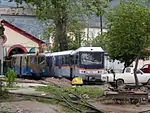 New (Stadler) and old (Decauville) rolling stock of the Diakofto-Kalavrita rack railway at Diakofto Engine Station. April 2009
New (Stadler) and old (Decauville) rolling stock of the Diakofto-Kalavrita rack railway at Diakofto Engine Station. April 2009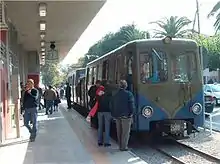 New (Stadler) and old (Decauville) rolling stock of the Diakofto-Kalavrita rack railway at Diakofto Engine Station. April 2009
New (Stadler) and old (Decauville) rolling stock of the Diakofto-Kalavrita rack railway at Diakofto Engine Station. April 2009.jpg.webp) Diakofto-Kalavrita railway station July 2009
Diakofto-Kalavrita railway station July 2009.jpg.webp) Station signage July 2009
Station signage July 2009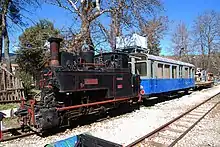 Cail narrow gauge (750 mm) steam locomotive ΔΚ-8001 and observation car ΑΒ ΔΚ-121 of the Diakofto-Kalavryta rack railway .
Cail narrow gauge (750 mm) steam locomotive ΔΚ-8001 and observation car ΑΒ ΔΚ-121 of the Diakofto-Kalavryta rack railway .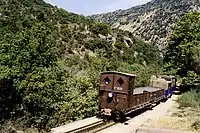 Gorge with mountain creek Vouraikos, January 2002
Gorge with mountain creek Vouraikos, January 2002
.jpg.webp)
.jpg.webp)

.jpg.webp)
.jpg.webp)
 Zachlorou village in Achaia, with Bridge in the foreground.
Zachlorou village in Achaia, with Bridge in the foreground.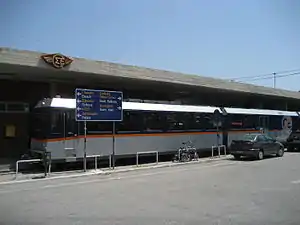 Diakofto Kalavrita railway station before the upgrades, July 2009
Diakofto Kalavrita railway station before the upgrades, July 2009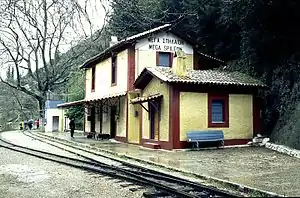 Mega Spileo railway station, May 1997.
Mega Spileo railway station, May 1997.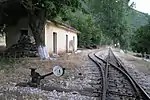 (Now disused) Kerpini railway station, July 2007.
(Now disused) Kerpini railway station, July 2007.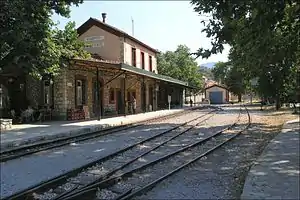 Kalavrita railway station, July 2007.
Kalavrita railway station, July 2007.
References
- https://www.gaiaose.com/
- "Η πρώτη περιβαλλοντική αδειοδότηση του Οδοντωτού από το 1896".
- "Network Statement 2007" (PDF). Archived from the original (PDF) on 2008-04-11. (1.29 MB). EDISY S.A., Athens, 2006.
- "Η ομορφότερη διαδρομή της Ελλάδας". 2 September 2017.
- "Η ομορφότερη διαδρομή της Ελλάδας". 2 September 2017.
- "Η πρώτη περιβαλλοντική αδειοδότηση του Οδοντωτού από το 1896".
- "Η πρώτη περιβαλλοντική αδειοδότηση του Οδοντωτού από το 1896".
- "Rack Railway of Diakopto - Kalavryta - Greek Travel Pages". www.gtp.gr. Archived from the original on 2019-10-04. Retrieved 2022-01-07.
- "Η πρώτη περιβαλλοντική αδειοδότηση του Οδοντωτού από το 1896".
- "The Rack Railway, Diakopto-Kalavryta, an amazing journey". TrainOSE. Archived from the original on 2021-12-10. Retrieved 2022-01-07.
- Ν. 4246/1962
- "Diakofto–Kalavryta Railway | Greece Activities". Lonely Planet.
- "Σιδηροδρομικός σταθμός - Μουσείο τρένων". Archived from the original on 2021-10-05. Retrieved 2022-01-07.
- "Ονειρικό ταξίδι με τον Οδοντωτό Σιδηρόδρομο (βίντεο-φωτογραφίες)".
- "Ο Οδοντωτός έγινε 120 ετών".
- "It's a new day for TRAINOSE as FS acquires the entirety of the company's shares". ypodomes.com. Archived from the original on 15 September 2017. Retrieved 14 September 2017.
- "Έτοιμος να ξανασφυρίξει και πάλι ο Οδοντωτός". 10 May 2020.
- H. Pyrgidis. Railway Transportation Systems (Greek: Συστήματα Σιδηροδρομικών Μεταφορών) (in Greek). Thessaloniki, Greece: Zitis. p. 702. ISBN 978-960-456-155-1.
- "Diakofto–Kalavryta Railway | Greece Activities". Lonely Planet.
- "Diakofto–Kalavryta Railway | Greece Activities". Lonely Planet.
- "Diakopto - Kalabryta project". Organismós Sidirodrómon Elládos (in Greek). Archived from the original on October 5, 2008. Retrieved March 29, 2008.
- Organ, J. (2006). Greece Narrow Gauge. Middleton Press. ISBN 1-904474-72-1.
- Simms, W.F. (1997). The railways of Greece. Wilfried F. Sims. p. 55. ISBN 0-9528881-1-4.
- "Diesel electric BDmh 2Z+4A/12 Rack-wheel train for the Hellenic Railways Organisation S.A. (OSE), Greece" (PDF). Stadler Bussnang AG. Archived from the original (PDF) on 2011-02-06. Retrieved 2010-10-06.
- "References: Hellenic Railways Organisation (OSE), Greece". Stadler Rail. Archived from the original on 2011-06-06. Retrieved 2010-10-06.
Further reading
- J.H. Price (September 1962). "Day trip to Kalavryta". The Railway Magazine. London, UK: Toothill Press Ltd. 108 (737): 642–645.
- Kalvryta guide
- Attractions in Kalavryta
- "Οδοντωτός (Odontotos)".
- "Organismós Sidirodrómon Elládos". Archived from the original on 2008-04-02. Retrieved 2008-03-28. Main Web site of OSE (in English)
- "Trip description".
- "Chemin de fer de Diakophto à Kalavryta : voie de 0m, 75 à adhérence et crémaillère : notice et dessins d'exécution"., A Gotteland; Mission Française des Travaux Publics, 1893, París : Auto J. Marchadier & Cie. {Book — 31 p. illus., plates, fold. map, fold. profile. 32 cm. }